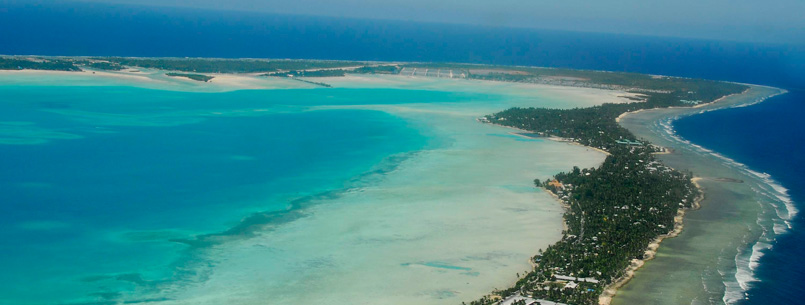2025 Kiribati Visitor Guide
The Republic of Kiribati consists mainly of the Gilbert Islands, a group of 16 low coral islands or atolls in the Central Pacific between 173 degrees and 170 degrees east longitude and 4 degrees north and 3 degrees south latitude. From north to south, a distance of nearly 800 km., the islands are Makin, Butaritari, Marakei, Abaiang, Tarawa, Maiana, Abemama, Kuria, Aranuka, Nonouti, Tabiteuea, Beru, Nikunau, Onotoa, Tamana, and Arorae. They are rarely more than six meters above sea level with a total land area of about 275 sq. km. Most of the Gilberts are atolls – oval, rectangular or triangular shaped lagoons enclosed by reefs on which rest many islets. The equator passes between Aranuka and Nonouti. The islands to the north are in certain ways culturally different from those to the south.
Kiribati also includes other islands than the Gilberts. Banaba or Ocean Island lies 400 kilometers to the west of Tarawa (capital of the Republic of Kiribati), and much further to the east of the International Dateline, the Phoenix Group with 8 islands, 1,120 kilometres E.S.E. and the Line Islands – 8 Islands 2,400 kilometres east of the Gilberts – a total of 33 Islands, the total area being about 3.5 million square kilometres.
Kiribati Environment
Because of the more favorable climate in the north, Babai (a taro-like plant) and mai (breadfruit tree) grow better there. In the south, especially in the old days, famine often plagued the islands owing to long periods of drought. Babai is grown in dugout pits and needs to be well cared for, or it dies. This is one reason why people in the south have always been known as more thrifty compared with the open-handedness of the north.
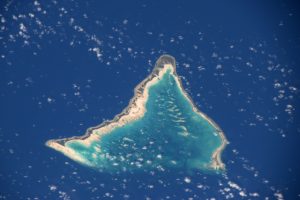
Coconuts were once stored in okai, small houses specially built for holding the nuts for future use in time of need, as during a drought or as a dowry when a daughter married. The pandanus fruit, which is seasonal, can be made into tuae, kabubu or karababa, preserved foods that can be stored for many years. Fish is salted and dried in the sun for future use, and coconut toddy is boiled to make kamaimai. Well-water can be very brackish. The houses, rectangular in shape and sometimes with raised floors, have thatched roofs of pandanus leaf and walls made with coconut frond sticks. In former years, people wore skirts made from coconut leaves.
As there is more sea than land, the only means of transport in the old days was the canoe. Such craft is still used for fishing and traveling short distances within the lagoon. A bigger version of the canoe, te baurua, was used for traveling among the islands. It was fashioned from the trunk of the uri tree (Guettarda speciosa) and was owned by the whole island or a village. Its manufacture took months and even years of arduous and skilled labor. Cord made from coconut husk fiber was used to bind the different canoe parts together. Today, te baurua is built with imported timber and other foreign materials.
Kiribati Culture
Kiribati dancing is an art. Like other social functions, it is rather formal with very little movement compared to the dance in some other Pacific islands. It may be very boring for those who do not know anything about dance in Kiribati. Appreciation comes from knowing something about the subject. I suppose that Kiribati dancing in its formality reflects the society, while in a more general view, it reflects the way people look at life. The singers sing and clap with all their might to make the dancing more exciting. The dancers and their concentration on movement – a time for the hands or feet to move, the position of the eyes, a time to smile and a time to look grave and serious – all of this may symbolize that amidst life difficulties, anxieties, and turmoil, life still goes on and there is always a time for everything.
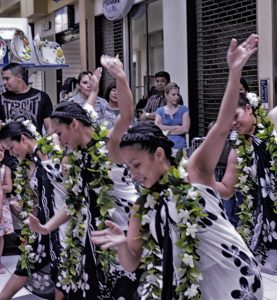 Robert Louis Stevenson wrote of Kiribati Mwaie (Ruoia) that was performed on one of the northern Gilbert Islands (Butaritari): “Of all the call to dance in the Pacific, the performance I saw on Butaritari was easily the best…Gilbertese dance appeals to the soul: it makes one thrill with emotion, it uplifts one, it conquers one: it has the essence of all great art: an immediate and far from exhausted appeal”.
Robert Louis Stevenson wrote of Kiribati Mwaie (Ruoia) that was performed on one of the northern Gilbert Islands (Butaritari): “Of all the call to dance in the Pacific, the performance I saw on Butaritari was easily the best…Gilbertese dance appeals to the soul: it makes one thrill with emotion, it uplifts one, it conquers one: it has the essence of all great art: an immediate and far from exhausted appeal”.
Allied with dancing is the arts of composing and weaving. Like other Pacific islanders, I-Kiribati loves to sing. Composing in the old days was always done by te iboga, a magician or sorcerer. The new song was created with the help of the anti. Te ibonga had to perform certain acts and observe certain rites afterward the words and tune of the song would come to him in a dream or be taught to him by the spirits. Te katake, a chant sung very slowly, was an old form of singing usually done by elderly men and women.
Weaving is a skill as well as an art, and the Kiribati women are very fine weavers. Designs used in weaving are family property, and mothers passed the skill on to their daughters. Besides weaving fine mats for sleeping, they also make baskets, hats, and fans. Pandanus leaves are used, and sometimes coconut leaves. The application of easily procured commercial dyes is not unknown today, no doubt in preference to local dyes which are prepared much more laboriously.
Besides the heritage of land, other family treasures consist of skills in fishing; forecasting the weather by observing clouds, waves, winds and birds; navigating by the stars at night and by birds and clouds during the day; building a canoe; cutting toddy; cultivating a Babai plant in a special kind of feeding (te ribana) to enlarge their size; medicine such as special drinks for treating certain diseases or illnesses; massaging and bone-setting; and embalming.
Towards the end of the 18th century, two British Captains Gilbert and Marshall discovered the central and northern islands of the Gilbert group which they named the Gilbert Islands (now Kiribati). A group further north was named the Marshall Islands. The Gilbert Islands straddling the equator are just west of the International Date Line. In 1890 Great Britain took control of the nearby Ellice Islands (now Tuvalu) which consisted of 9 islands and, in 1892 the Gilbert Islands became a British Protectorate.
The Gilbert Islands
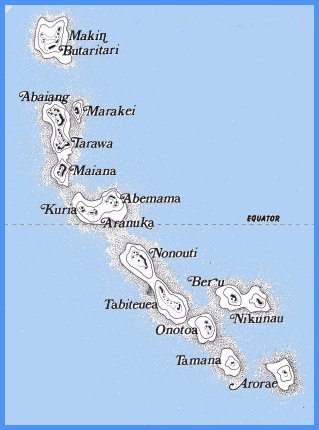
The Gilbert Islands, administered by the Ellice Group, formed one of the few remaining British Crown Colonies in the Pacific. Its administration center was then in Honiara in the British Solomon Islands Protectorate (now the Solomon Islands), but a Resident Commissioner had headquarters in Tarawa (capital of the Republic of Kiribati). The colony covers almost a million square miles of ocean and includes the Line Islands (eight islands, including Christmas, Fanning, and Washington Islands) and the Phoenix Group (eight islands). Perhaps the best-known island in the Phoenix Group is Canton Island, which became an airbase during World War 2 and, in the early post-war years, a refueling stop for trans-Pacific air services. With the development of longer-ranging aircraft, it has been relegated to the category of an emergency airport.
The Republic of Kiribati is a lovely vacation destination. Of course, the best vacations require planning and budgeting. Other islands of some importance were then Ocean Island (Banaba), and now Christmas and Fanning Islands. A consortium representing Australia, New Zealand, and the United Kingdom has worked on the valuable phosphate deposits of Ocean Island for many years. The Japanese occupied it during World War 2, but it saw no action. Fanning Island, until 1963, contained a repeater station for the trans-Pacific cable service between Canada and Australia. Then a coaxial cable replaced the old link and eliminated the island’s function. During World War 2, the United States and New Zealand forces garrisoned Christmas Island, a neighbor of Fanning Island in the Line Group, and, in post-war years, both Britain and the United States conducted nuclear tests there.
In 1979, the Gilbert Islands gained independence from Britain and became the Republic of Kiribati. The coconut economy of such coral islands as those of the Kiribati Group is a difficult one, demanding the utmost of the inhabitants. The idyllic life depends, not on the beneficence of Nature, but upon the resources and energies of the people. Here human has had to develop techniques that permit survival. To grow taro or Babai, the starchy root that is one of his main food crops, he must excavate a pit about twelve yards square and perhaps two yards deep – deep enough, anyway, to reach down to the table of freshwater that collects at sea-level below these porous islands where no freshwater flows.
He may only do so once every twenty years or so, but the labor is enormous. In the pit, the farmer keeps a constant plantation of taro growing replanting the tops as a cutting whenever he harvests the root. He can do this at most seasons, but since the vegetable takes a year to develop, his pit must be large enough to feed his family for that length of time. Other staples are the coconut and, in season, the breadfruit. But the taro pit requires constant cultivation, the farmer building baskets around each plant to secure the liberal applications of leaf mold without which it could not thrive.
The coconut and the pandanus provide house-building materials, the open, airy houses being raised on palm-trunk piles, fastened with coco-fiber rope, and roofed with pandanus. An almost necessary addition to the family menu is the juice (toddy), collected from the young flower shoots of the coconut palm. Most of the economy centers on the lagoon and the reef; the men fishing each day from canoes; the women and children walking the reef at each low tide to collect reef “animals” like the octopus, the clam, and the crab. The other food supply comes from pigs and hens, staples of the economy throughout the Pacific.
But the joy of island life comes most deeply from the well-developed social sense of the islanders, their joy in singing and dancing, and the extrovert happiness with which they share every piece of good fortune that comes their way.
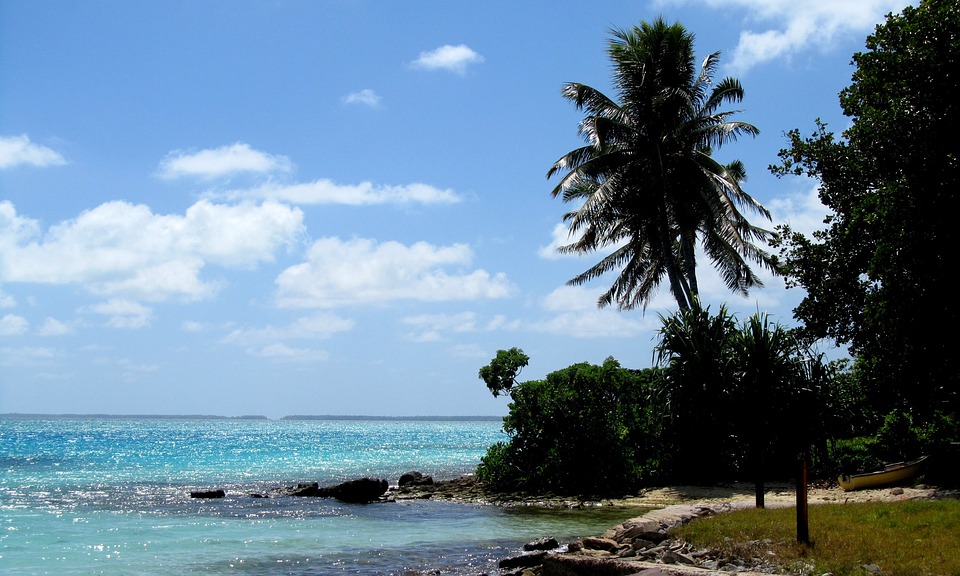
Tarawa
1999 saw the capital Tarawa developed into a first-class accommodation destination being serviced by Air Nauru and packages combining Nauru and Kiribati (Tarawa) can be obtained from Australia with departures from Melbourne, Sydney, and Brisbane. Christmas Island has limited Aloha charter flights/Coral Pacific Airlines from Honolulu only. Visas are required for entry to the Republic of Kiribati, including Christmas Island.
If combining Tarawa with Nauru, accommodation in Nauru is at the Menen Hotel. Prices are in Australian dollars and are valid from 14th October 1996. Tarawa may be combined with Pohnpei, Guam, and the other islands of Micronesia. Kiribati packages include economy airfares, accommodation, continental breakfasts in Tarawa, and airport transfers. Departures from Melbourne on Friday evening, or Brisbane early Saturday morning. Kiribati may be combined with Nauru. Prices on request.
HOTELS
Accommodation in Tarawa is at the Otintaai Hotel which is available to satisfy every requirement from the most luxurious to accommodations that will allow the visitor to experience the traditional lifestyle.
The Otintaai Hotel offers 40 air-conditioned rooms with private facilities. Rooms have a fan, refrigerators, tea/coffee facilities, and a balcony overlooking the lagoon. Each room also is equipped with an International Direct Dial (IDD) telephone. Visitors staying at the Otintaai Hotel can be picked up from the airport and deposited at the airport when they depart. Rental cars are also available for sightseeing and shopping. Telephone: +686 28084; Facsimile: +686 28045
The Tarawa Hotel is located at Ambo on South Tarawa and offers six rooms with private cooking facilities, two toilets, two showers, two kitchens, two lounges, and refrigerators. It is situated close to the main road, handy to public transport and is opposite the famous Ambo Lagoon Club. Telephone: +686 21445
RESTAURANTS AND NIGHT SPOTS
The Royal Bar is situated near the center of the Betio islet. It is fully air-conditioned, and cold beer and soft drinks are always available. The bar opens every evening from 4 p.m. to 10 p.m., and later at weekends. It is the favorite haunt of many expatriates and is the weigh station for the Betio Game Fishing Club.
Ambo Lagoon Club is situated on the lagoon side and incorporates a variety of entertainment. These include a swimming pool, volleyball, a safe swimming lagoon and a dart facility. There is also a large Maneaba (meeting house) incorporating a bar which is ideal for that special party. Everybody is always welcome at the Ambo Lagoon Club.
The Night Spot is one of Kiribati’s dancing places. A visitor is always welcome at the Night Spot where you can enjoy yourself dancing and drinking with many young pretty girls and for the ladies meeting handsome young men as well as more mature men!! The Night Spot is open every day of the week, so a visitor is always welcome to join in the fun.
SHOPPING
One Stop is a small supermarket situated in the Government’s center of Bairiki, Tarawa. It has a wide range of fresh, frozen, and dried goods and is open seven days a week from 8 a.m. to 7 p.m. Fresh fruit, vegetables, cheese and yogurts are imported weekly by plane from Australia. All staff are English-speaking and are famous for their friendly service.
Fern is one of the supermarkets in Tarawa. It sells fresh vegetables, chicken, meat pies, clothes, and everything that a visitor needs to buy, including a selected range of wine. Visitors are always welcome at the Fern store which opens seven days a week.
SPORTS AND OTHER ACTIVITIES
Sailing and other water sports, fishing, soccer, cricket, squash and tennis are popular sports and now there is a diving club in Betio as well as a diving resort in North Tarawa. Bottle and weight belts are supplied, but divers should bring their own regulators, masks and fins. Advance booking is essential because the amount of rental equipment is limited. To prevent coral cuts, sandshoes should be worn when walking on the reef.
A favorite swimming area in Tarawa is on both sides of the Dai Nippon Causeway around the area close to the channel or off the small islets of North Tarawa. There is a 36 Norman Cross trimaran with sail and auxiliary power available for charter by the day or for longer periods. It is fully equipped with all safety equipment and has a professional skipper. Its day capacity is up to 17 persons and overnight is eight. Advance booking is essential at Facsimile: +686 28539.
Sightseeing is popular, in particular, the wide variety of World War 2 relics still evident on Betio islet. If the visitor is lucky enough, he may be at Tarawa on the night of a flying-fish drive, when islanders paddle their outriggers or boats to stations at spaced intervals around the lagoon. Each canoe carries a torch of burning coconut stems, and the whole lagoon seems dotted with lights, each flame expanding and contracting with movement, and in its spasmodic glow lighting the beautiful brown skins of the fishermen. The flying fish break the surface and fly toward the lights, only to strike the nets and drop into the hull of the canoes. Fish that are not immediately eaten are sun-dried and used as reserve food.
For the above, the Gilbert Islander has to be ever on the alert. The rainfall of his island may vary between fifteen inches or a hundred and thirty from year to year; crops can fail. But his Micronesian heritage stands him in good stead; he can survive happily, and raise his laughing children where humans from more fortunate places would perish from want. For him, life is relaxing; but relaxation is an attitude of mind and a communal one.
HANDICRAFT
Handicraft centers and shops are located on South Tarawa and provide a variety of local handicrafts for sale to visitors. These include shark tooth swords, local fans, mats, trays and wooden spears. Contact the Itoiningaina Handicraft Centre, Teaoraereke, Tarawa, Telephone: +686 21038, the RAK Handicraft Centre, Tangintebu, Telephone: +686 21132 and the AMAK Handicraft Centre, Bikenibeu, Telephone: +686 28517.
Aspects of Kiribati
A typical Gilbertese (Kiribati) island of the Gilbert Group shown below normally consists of a strip of land, an encircling belt of the reef and a lagoon. The strip of land, covered with coconut palms is almost on the same level as the high tide. The highest points are scarcely more than a man’s height and comprise sand dunes formed by a wave stronger than the others – or are shoveled-up heaps of earth left by people who have been digging a pit in which to plant Babai. The islands of Makin, Kuria, Nikunau, Tamana, and Arorae have no lagoon.
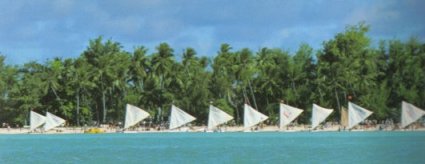
A typical Kiribati (Gilbertese) village is clean and tidy with the ground covered by a white layer of coral fragments. Rows of huts line each side of the road and these are sometimes concealed amongst breadfruits and pawpaw (papaya) trees. The open-sided huts are pleasant and well ventilated and are all built on the same model. Every family has three: a house, a kitchen and a storeroom. The house is simply a rectangular roof some six feet above the ground, thatched with pandanus leaves and supported by four posts. At about table height, there is a very springy floor made of flexible laths. Between the roof and the floor, coconut-frond mats act as blinds and windbreaks which are rolled up during the day.
The maneaba is the center of the village and next to the war canoe, it is the masterpiece of Kiribati (Gilbertese) culture. Like the houses, it is built in a rectangular shape and the architect is normally a village elder who has learned his trade through experience and from tradition in his family. The construction of the maneaba is undertaken in strict accordance with rites and rules which are always carefully applied.
The maneaba is well adapted to the island climate and to its function. Its roof is supported on shoulder-high stone pillars and all who enter have to stoop. The Gilbertese are very comfortable in the maneaba. It is wide, cool and airy and in it the people feast, dance and sleep – sometimes all at the one time. There are no constraints in the maneaba. Here, you might even see a Gilbertese bringing in his grandfather’s mummified body to honor the dancing and the skulls of defeated warriors were traditionally lined up.
Villages and districts both have their maneabas. They are divided into two groups with different names for those in the south and the north. Some names, such as Maungatabu – sacred mountain – clearly indicate a Samoan origin. Each maneaba has a name, traditions and personality. All the way around, the maneaba is divided into places and each family has a set position in official gatherings. A stranger who is guest in another maneaba enters it under the same beam as he would in his home maneaba. Anyone, who belongs to several families, chooses the least cluttered place to sit. As far as official feasts are concerned, there is a strict code of etiquette to observe. One clan supplies heralds who announce what the shares of food will be; another family is responsible for distributing the food. The portion of honor belongs to such and such a family and in sharing out food a fixed order of precedence is strictly followed. The least mistake for the slightest forgetfulness is taken as an insult.
Fish is a very necessary part of Gilbertese life. There are no markets and each man fishes on his own account. Catching fish is a problem that is only solved through determination and use of intelligence. The well-populated islands consume an enormous amount of fish with one extended family using up to 20 kilos in two days.
The islands don’t always have the same share of facilities. Some have no lagoon while others have the villages badly placed if they wish to send canoes out into the ocean. A different type of fishing is required from one day to the next as the fish are always on the move. Sometimes, there is no canoe, sometimes no net or no line. Most often, the fisherman fails in some way: in health, in determination or in courage. On some islands, many of the young men do not sail a canoe any more and all fishing is done using a net from the shore. Under these circumstances, their families are often forced to eat nothing but the smaller fish.
The fishing ground might be the shore, the lagoon, or the open ocean. There are different types of fish in each place. The best place to fish is normally the rocky line of reefs around the island. In the coral chambers and grottos, there are a thousand types of fish. This area is also usually the most impossible to reach because of the great breakers which constantly batter against the reef. The patches of rock scattered about the lagoon are also rich in fish. The best fishing ground, however, is in the open sea within about ten miles around the island. The farther away from the reef one goes the less chance there is of good fishing.
